Israel stands out among high-income countries for its relatively young population. Although its population age 65 and older is projected to more than double through 2050, Israel will still have the youngest population among OECD countries, largely a result of its comparatively high fertility rate. Despite the lack of demographic pressure, Israel has been ahead of its time in terms of developing various long-standing social programs and a robust network of support for community centers and caregivers to accommodate a healthier, and more productive and engaged older population. This is partly thanks to cultural values focused on social inclusivity, as well as honoring the generations who founded and built the country.
Israel boasts high levels of labor force participation, compared with other OECD countries. The government actively engages in promoting the employment of older people and improving their employability, often in collaboration with non-governmental organizations (NGOs). For a relatively young country, Israel also stands out for its early planning to ensure access to, and comfort with, technology. In line with the “Startup Israel” ethos, tech companies are moving into the silver economy, innovating new products and services to ease access and improve well-being.
As of 2015, only 11.2 percent of Israel’s total population was 65 and older, just over two-thirds of the average of its peers. By 2050, the share is projected to reach just 17.4 percent, the lowest among OECD countries. Israel’s fertility rate is comparatively high − 3.05 children per woman from 2010 through 2015, nearly double the average of high-income countries.
Source: UN Population Division
Percentage of Population Age 65 or Older and Children per Woman
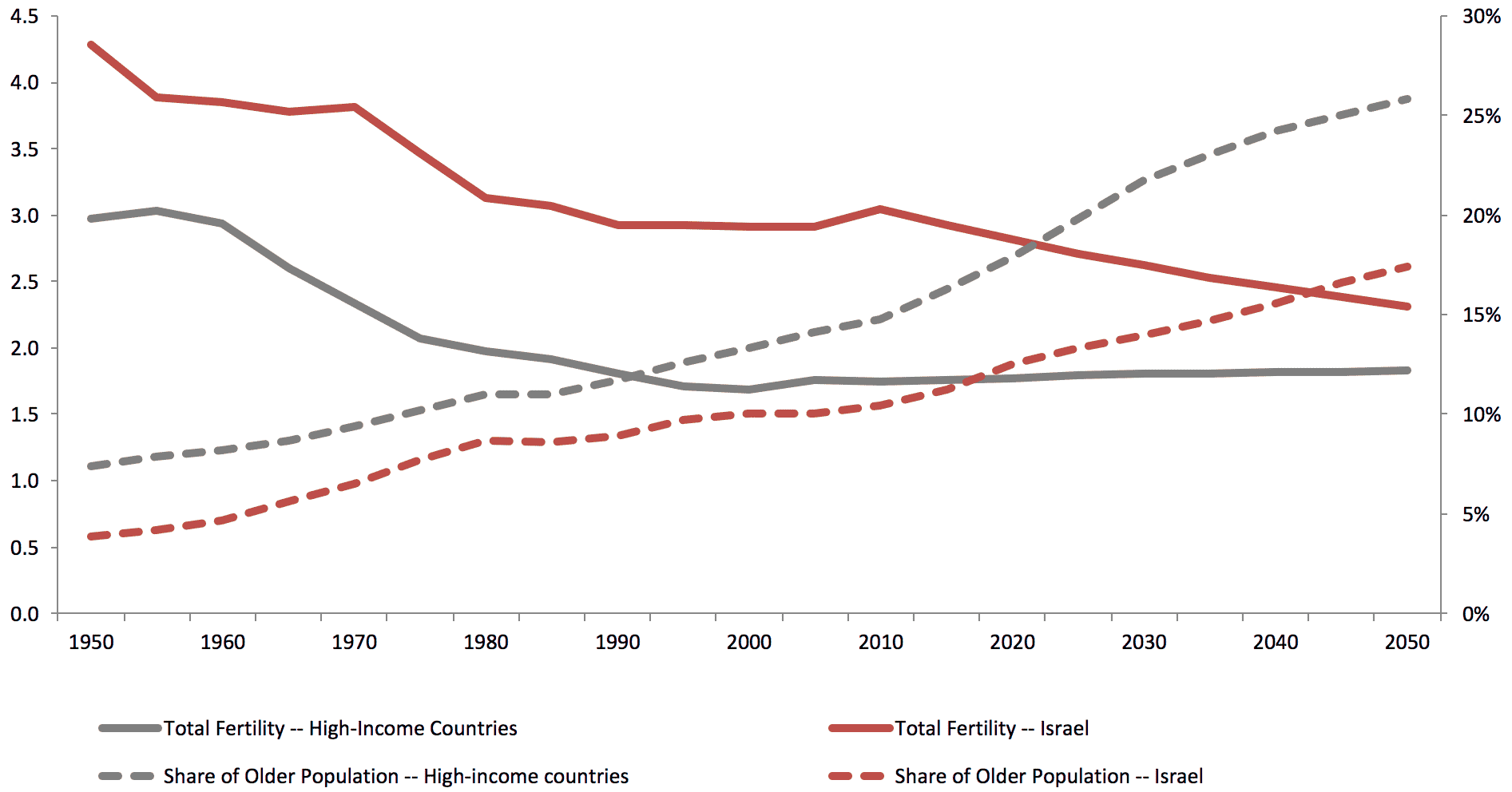
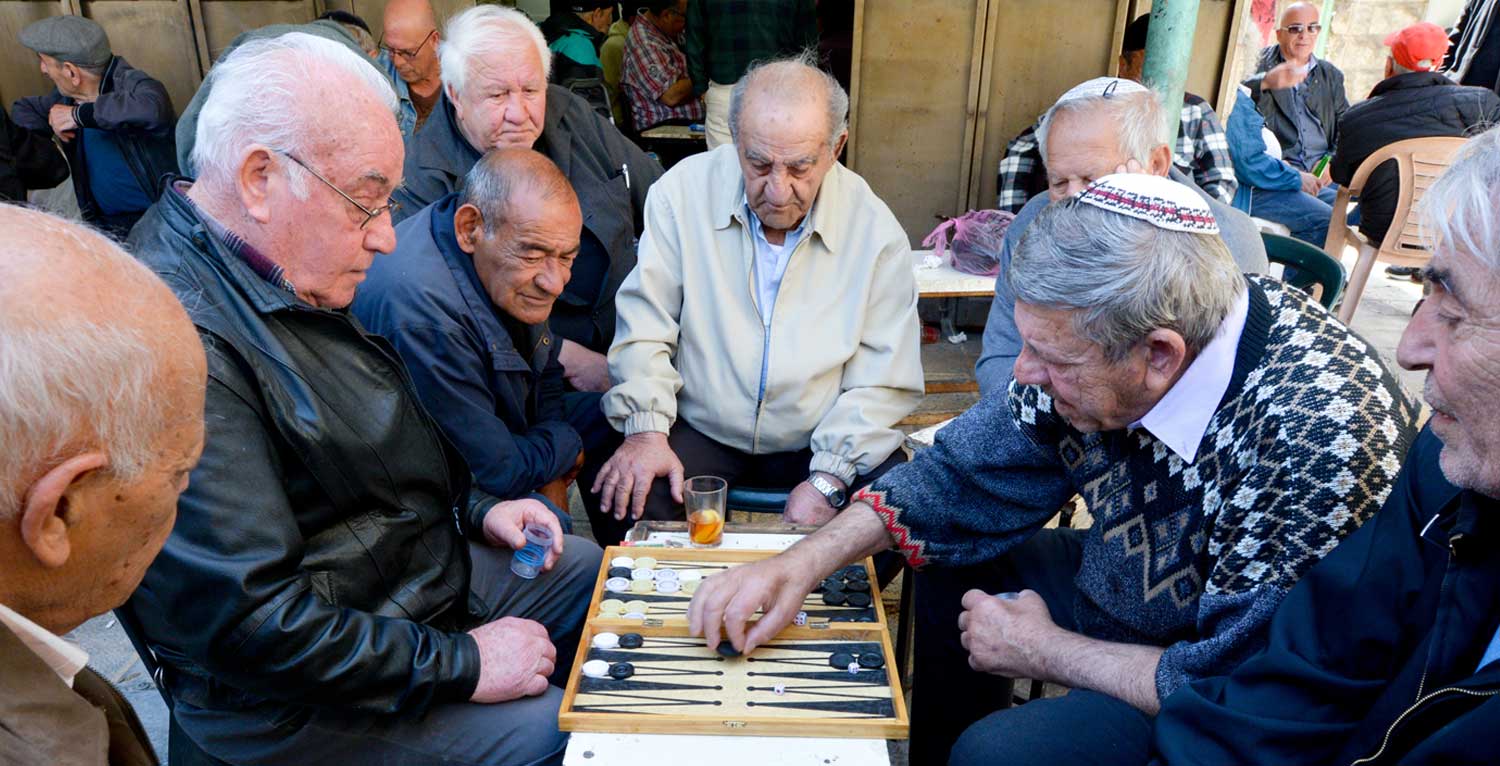
Community Social Infrastructure
Cultural and historical factors have produced a deep respect for older Israelis by the broader society. The current generation of older people (particularly those age 75 and older) played a central role in building the country after its founding in 1948. These cultural values are reflected in the many long-standing programs operated by the government, often in collaboration with NGOs, to enable active aging and community-based engagement. In recent years, they have grown to include a focus on intergenerational connections and the integration of recent immigrants. A variety of government efforts have also been made to improve the accessibility of public facilities and transportation in order to maintain older adults’ independence, but enforcement of relevant regulations needs to be strengthened at the local level.
More than 70 percent of older Israelis were not born in the country, and nearly 22 percent of older adults immigrated to Israel after 1990, the majority from the former Soviet Union.
Around 97 percent of Israelis age 65 and older live in their communities, as opposed to institutional care facilities, and nearly 70 percent of them live independently.
The “Here We Live” (“Kan Garim”) Program
One of the most innovative programs is “Here We Live,” which connects older adults and students in a novel housing model that addresses the needs of both generations. The Ministry of Construction and Housing launched the pilot in 2014, in conjunction with the Ministry for Social Equality and the National Union of Israeli Students. The program matches college students with older adults who can care for themselves independently and have a spare bedroom at home. The program aims to reduce loneliness of older adults and enhance their connection to younger generations, while making higher education more financially accessible. A student participating in the project pays only NIS 250–300 (approximately USD 65–80) per month for rent and expenses and receives an NIS 8,000 (approximately USD 2,110) scholarship, which is equivalent to between half and two-thirds of the average tuition cost. In exchange, the student is required to sleep at the host’s home at least three nights per week and to engage in social activities with the older adult for at least five hours per week. The program was successfully piloted in the school year 2014–2015 with over 100 matched participants. The number more than doubled in the 2016–2017 year, with 3,700 students and older adults applying to participate. The program is now being replicated in the United Kingdom and studied by other countries.
“The spirit of the program is the most beautiful part of it. These students are actually thanking the older generation that founded and created the country. Giving and taking – that is actually the real aim of the program.”
– Adi Vahav, Special Project Manager, Ministry of Construction and Housing
Productive Opportunity
Israel has relatively high older-age labor force participation, compared with other OECD countries, partly due to its pension system and retirement age reform in the early 2000s. As the population continues to age, the government is paying greater attention to older adults’ economic participation. A variety of policies and programs have been put in place, often in collaboration with NGOs, to create employment opportunities for older adults and to improve their employability, with an emerging focus on helping older job-seekers tackle online job applications. One potential policy that could also immediately boost older adults’ participation in the labor force would be to raise women’s retirement age, an idea that has been controversial.
Labor Force Participation Rate Age 65 or Older in Normal Pensionable Age 2015
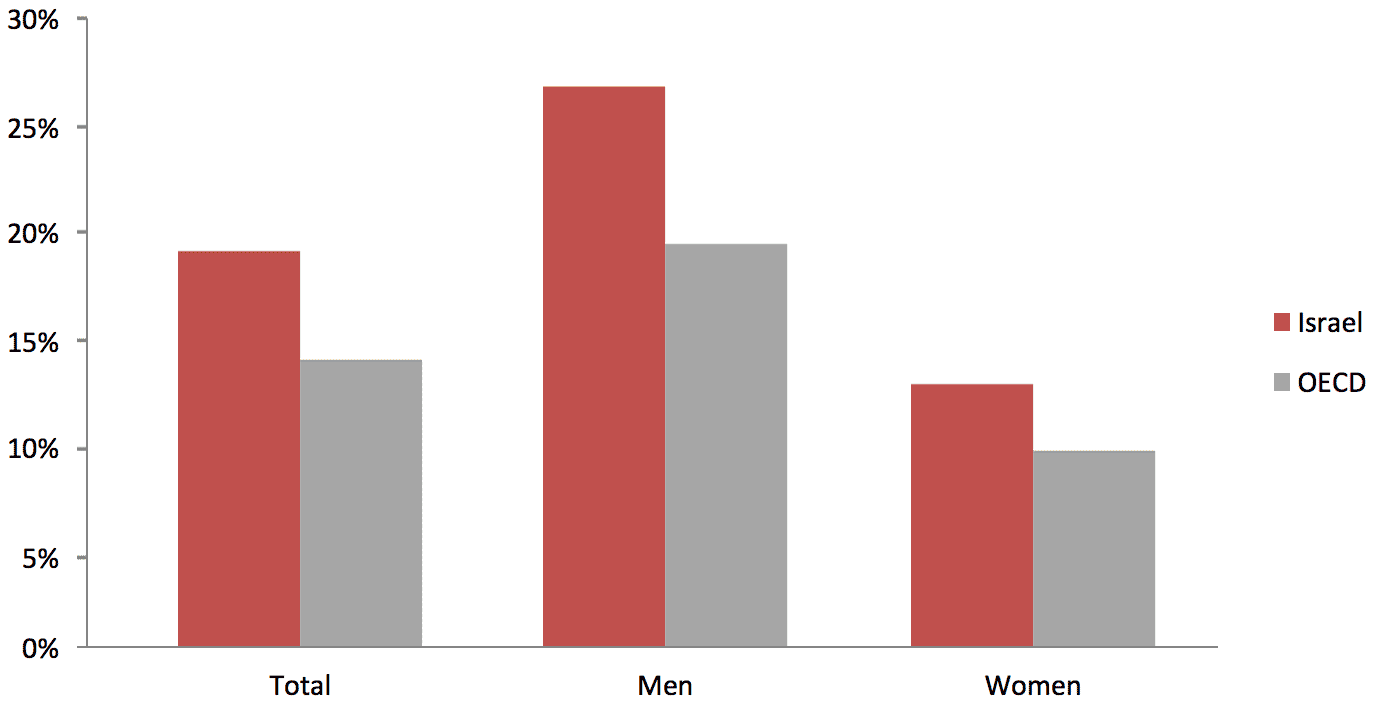
Normal Pensionable Age
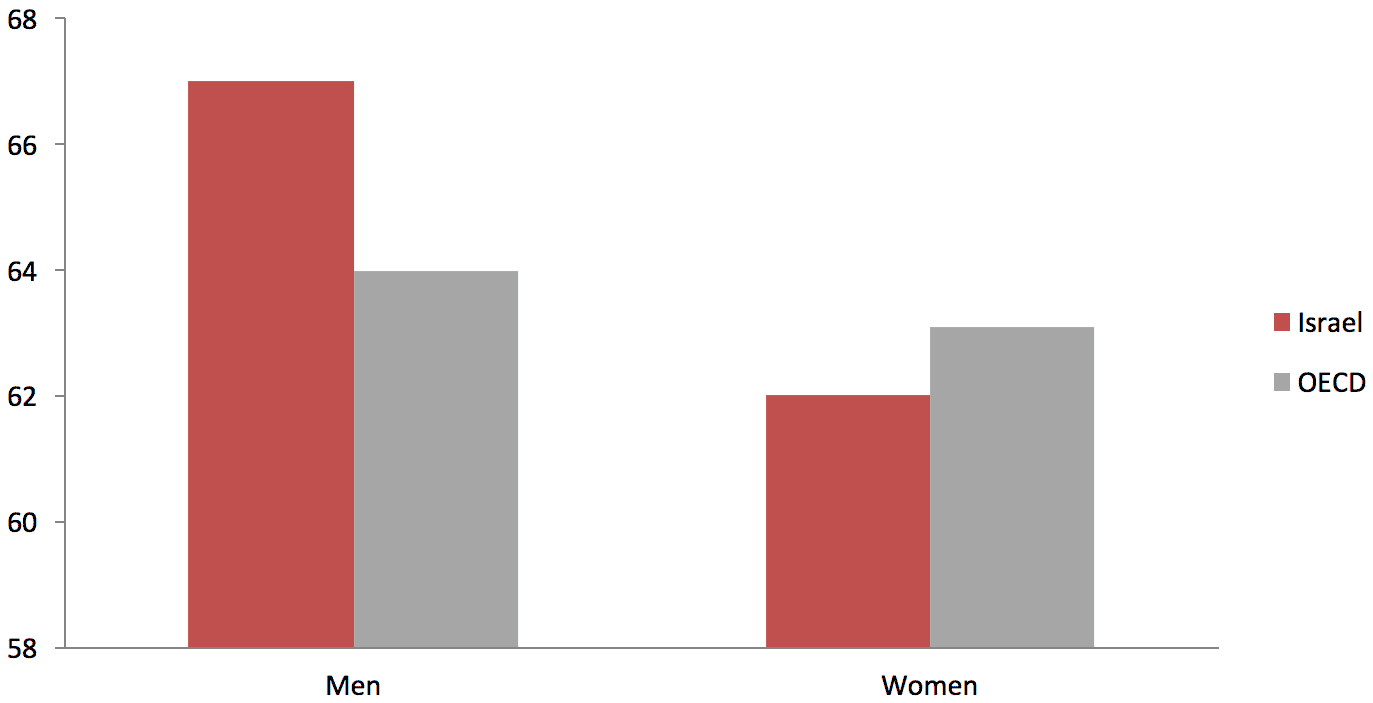
The “Experienced Wanted” (“Darush Nisayon”) Program
Older job-seekers in most countries today tend to struggle with online job applications due to a lack of familiarity with new digital tools. An innovative online job portal called “Experienced Wanted” could provide a solution. The job portal was established in 2015 by the NGO “Vehadarta” (meaning “And Respect”) and the Ministry of Social Equality and is the country’s flagship online job platform dedicated to older adults. Using their website, registrants submit their résumés and can seek guidance and advice through a hotline. Staff screen the résumés and pass them to relevant employers while maintaining contact with applicants throughout the process, as well as conducting follow-ups after placement. Support provided throughout the process is particularly important, according to Vehadarta’s CEO, Rivi Beller, since many older adults are not used to applying for jobs online and often become frustrated when they do not hear from employers receiving a high volume of applications. So far, over 10,000 people have registered on the site, and 50 to 60 receive job placements every week. The majority of jobs are in finance, accounting, quality assurance, and, on a part-time basis, investigation or inspection (for example, testing quality at supermarkets or restaurants).

Technological Engagement
Dubbed the “Startup Nation,” Israel’s technology sector has begun to move into the aging-related market in recent years. A number of aging-tech startups and projects have emerged, which are based in Israel but keen to tap global markets. Policy efforts have also been made to improve digital literacy, helping to reduce the digital divide between older and younger populations and contributing to increased adoption of digital devices among older adults.
Percentage of Population Using Digital Technologies
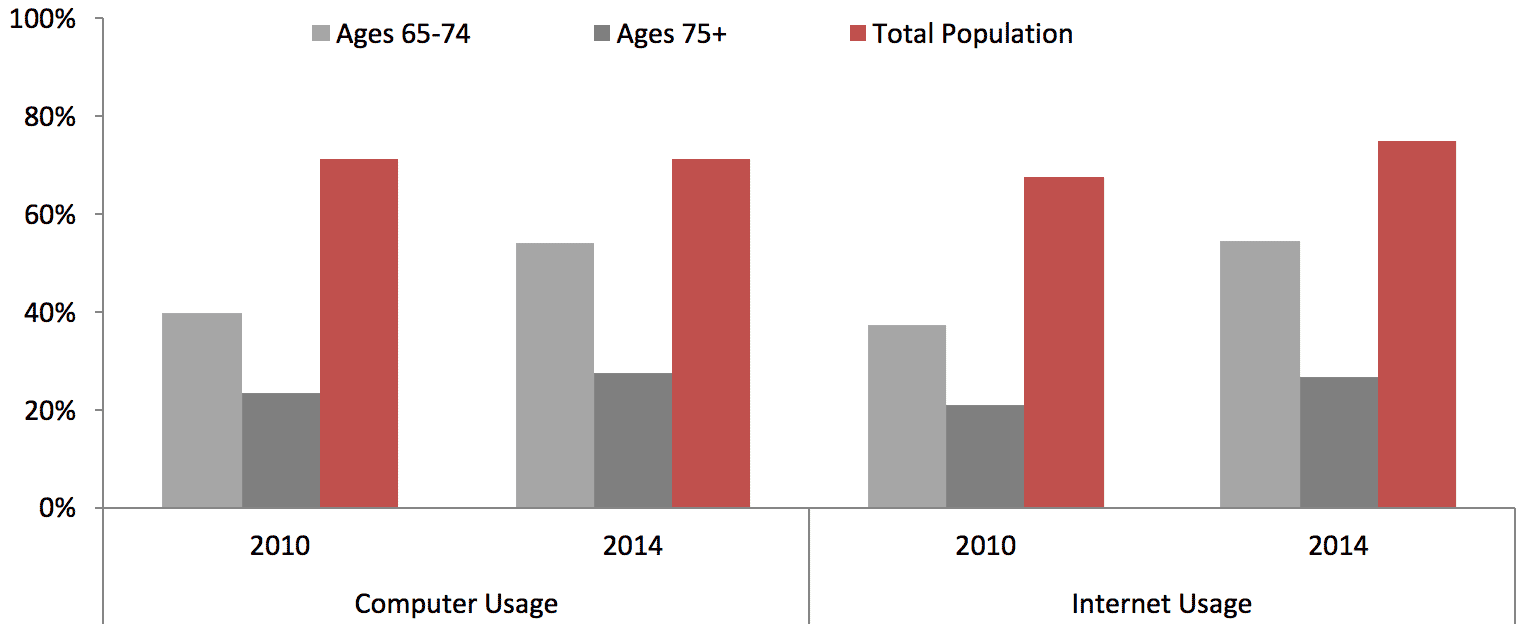
The country’s digital divide is most pronounced among those 75 and older. More than half of those ages 65 through 74 use the Internet and computers, and they are rapidly closing the gap with the general population.
Source: Israel’s Central Bureau of Statistics
Reducing the Digital Divide
The Israeli government started to build LEHAVA centers (“LEHAVA” is an acronym for words translating to “reducing the digital divide in Israeli society”) in 2002, to expand access to computers and the Internet. Free courses are offered at these centers, covering the basics of Internet use and certain software (e.g., Excel, Word, PowerPoint, and Photoshop). Today, there are 30 such centers around Israel, where 60,000 to 70,000 people have taken courses, and 100,000 have used the facilities. Representatives of the LEHAVA program note that older adults have demonstrated particular interest in using the Internet for information searching (e.g., government websites, recipes, and travel) and for social aspects (e.g., social media and online picture albums). Given that children and young adults make up 70 percent of participants, one interesting approach that several of the LEHAVA centers have taken focuses on intergenerational programs, where older adults and their grandchildren work on a project together, such as compiling a slideshow. Similar intergenerational projects have been initiated in other programs that also have computer-training components. These include the “Elderly on the Move” program, where members of youth movements participate in activities with senior citizens, including computer lessons, and the “Through the Eyes of the Elderly” (“Mizkeinim Etbonen”) program, where youth help older adults compose their personal and life stories using a computer to add to a family tree database.
Healthcare & Wellness
Both life expectancy and healthy life expectancy in Israel are among the highest in the world and continue to extend. As in most other countries, however, the increase in “healthspan” tends to lag behind “lifespan.” In response, the government has focused on supporting home and community care services. As in many countries, Israel’s LTC system is highly fragmented in terms of care providers, regulation, and financial responsibilities, resulting in service gaps, duplication, inefficient incentives, and inadequate investment in prevention and rehabilitation. However, reform has been put on hold, partly due to budgetary concerns.
Life Expectancy and Healthy Life Expectancy
(At Ages 60–64; in Years)
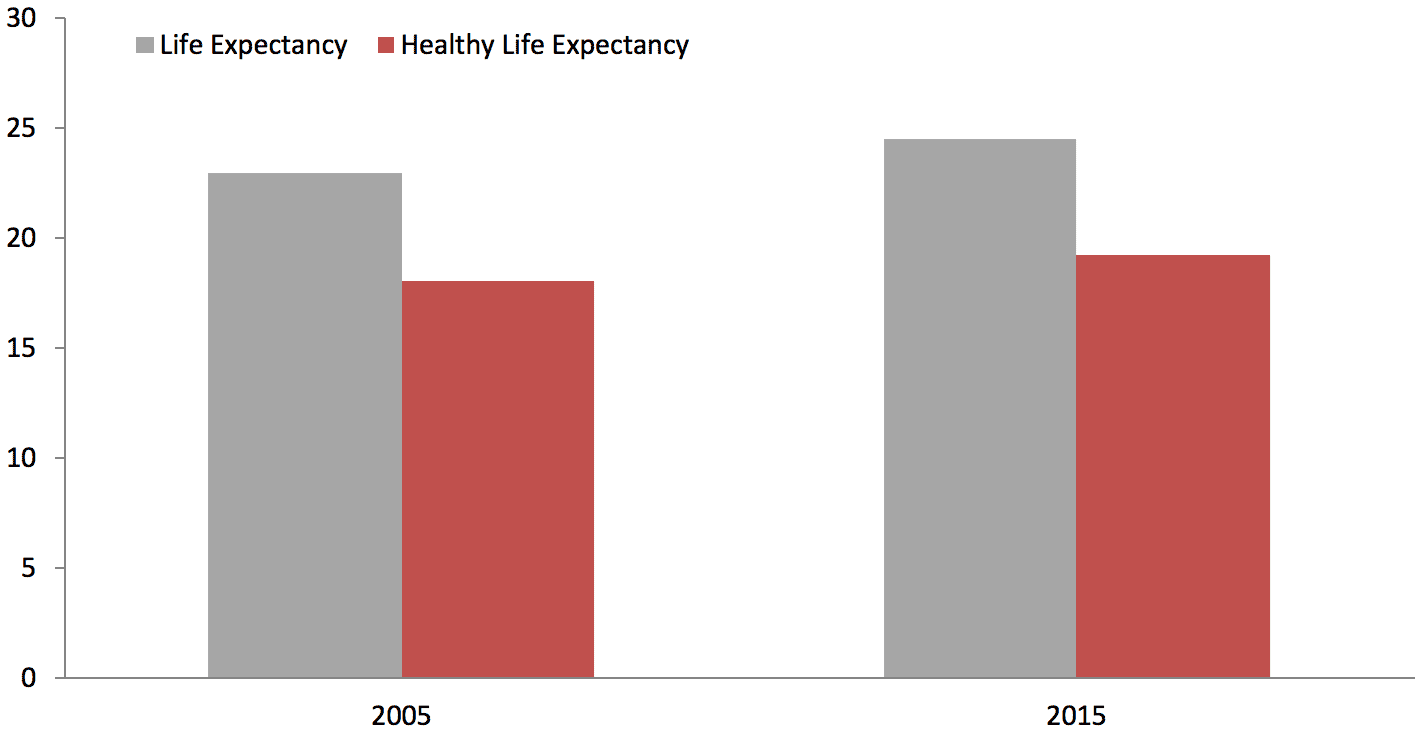
Over the past decade, while the life expectancy of people ages 60 through 64 grew by 1.6 years, the improvement in the healthy life expectancy lagged behind, increasing by just 1.2 years. Among older Israelis who live at home, nearly 35 percent have difficulties with mobility, and 16 percent have significant difficulty or are unable to perform basic daily living functions.
Since Israel’s introduction of the Long Term Care Law in 1988, older adults who receive home care have reached 19 percent of the total older population, nearly 10 times as many as before. During the same period, the number of day care centers more than tripled from 52 in 1990 to 163 today.
Support for Informal Caregivers
For a relatively young country, Israel has surprisingly comprehensive policy support for informal caregivers to ensure their well- being and the quality of care they are able to provide. Informal caregivers, often family members, provide most of the care for older adults in Israel. It is estimated that 30 percent of Israeli adults (age 20 and older) provide informal care, and that half of them are employed. In 1964, Israel introduced a range of labor and tax policies that provide financial assistance to employees who provide care to older parents or relatives, including: severance pay for eligible people who resign from work in order to provide care to sick relatives (1964), tax exemption for employees who finance parents’ placement in care institutions (1980), and annual paid sick leave of up to six days that are taken because of the sickness of a parent or spouse (1993). However, experts have noted that the range of those eligible is narrowly defined, and it is unclear whether the general public is aware of these benefits. Moreover, caregivers may opt not to benefit from such policies as they worry that it could affect their professional prospects.